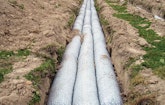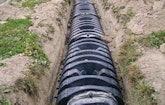
Interested in Repair?
Get Repair articles, news and videos right in your inbox! Sign up now.
Repair + Get AlertsDrainfield media products are crucial components of onsite wastewater treatment systems. Historically, we have gone from the days of simple outhouses, when nothing more was needed, to strict regulations governing the size and design of most septic systems. As part of that evolution, a host of media options have emerged, giving installers effective and easy-to-use choices with which to complete effective, long-lasting drainfields on nearly any site.
Drainfield media came into play after indoor plumbing added to the quantity of wastewater that needed to be managed. First, open-joint piping was introduced. Then aggregate was placed around the open joints, and the drainfield was born. Although it was already widely used, aggregate was first listed in the Manual of Septic Tank Practice, published in the 1950s by the U.S. Department of Health, Education, and Welfare as part of the first national standard.
Evolving options
Today, in some regions, aggregate is still the conventional choice for septic system drainfields, and many installers continue to use it. But just as TV sets evolved from black-and-white, to color, to flat screens with high definition, newer products have arrived for drainfields.
Numerous drainfield products are available – in fact there are too many to describe fully in one article. Aggregate still serves its purpose, but in many cases it is replaced by newer technologies that work better and cost less.
Aggregate has a large carbon footprint and can have larger environmental impacts just in the effort it takes to obtain it and prepare it. Its production and use involves mining, blasting, crushing, hauling, washing and dust control. It is also labor-intensive and can cause extensive site disturbance during installation. Advances in technology and science have led to alternatives that better protect the environment and the homeowner’s investment overall.
Conventional drainfields
In a conventional system, effluent flows by gravity or is pumped to the drainfield, typically constructed with 4-inch perforated PVC pipe installed level or with a very slight slope over 6 inches of aggregate. Aggregate is then placed along the sides of the pipe and 2 inches above it. In the past, straw or building paper was laid over the pipe, but today, filter fabric is most commonly used to prevent silting. The system is then covered with soil. According to the U.S. EPA Onsite Wastewater Treatment Systems Manual (2002), aggregate functions include:
Storing effluent until it can be released
Supporting the sides of the trenches, the soil above, and the drain piping
Distributing effluent along the trench
Aggregate alternatives
The alternative media used in aggregate-free trench or bed systems function similarly to aggregate and offer benefits to installers and the environment. Advantages include:
Lightweight and easy handling
Lower labor and transportation cost
No compaction or other structural damage to soils and no property disruption from heavy machinery
Possible drainfield size reduction
No clogging from aggregate dust and fines
Can be pressurized for enhanced system effectiveness
Easy operation and maintenance, including addition of observation ports for system monitoring
Alternative drainfield media include technologies such as engineered aggregate, concrete and plastic chambers, fabric-covered pipe, and corrugated pipe. Other options under development include crushed glass and rubber tire fragments. Even within the realm of options already available, product enhancements for specialized applications and extremely sensitive environments are in development and will give installers future options for nearly every possible type of installation.
Engineered aggregate
An environmentally friendly replacement to traditional aggregate and pipe drainfields, engineered geosynthetic aggregate systems feature a modular design. These systems, available for more than 20 years, improve drainfield performance by eliminating the fines found in crushed aggregate and by reducing soil compaction and embedment.
Engineered aggregate is normally offered in preassembled units, which include perforated pipe surrounded by engineered aggregate and held in place with durable, high-strength netting. Most are available with filter fabric preassembled within the unit. These units, or bundles, are manufactured in multiple sizes, in bundles from 6 to 18 inches in diameter and typically in 10-foot lengths, easily coupled together to provide the specified trench length.
Plastic chambers
Plastic chambers are open-bottom arches of various sizes and shapes with louvers for sidewall infiltration. These chambers form voids through which effluent flows, replace the voids within the stone aggregate and provide a large, open surface, free of fines, to maximize effluent infiltration to the soil.
Chambers are installed in level trench and bed systems. Chamber sections are designed to interlock, forming a complete drainfield trench that includes end plates. Some chambers are manufactured so that they permit curving the system to fit unusual terrain.
Plastic chambers can reduce installation time by up to 50 percent compared to an aggregate system. All states and provinces have approved chamber systems, and most allow reductions in drainfield size where this technology is used instead of aggregate.
A typical chamber is 16 to 34 inches wide, 4 to 5 feet long, and 8 to 16 inches high. Special end sections connect with feed piping. A number of design options are available, depending on the depth, slope, and size of the system. For example, narrower chambers provide more sidewall absorption, and low-profile models are used in shallow drainfields or mounds where high water tables are present.
Chambers are installed and then covered with soil. They receive septic tank effluent and allow it to infiltrate through the open bottom and the side louvers into the soil, where final treatment and dispersal occurs. Chambers are lightweight and easy to install, eliminating the labor, equipment, and hauling costs that go with aggregate.
Most chambers stack, easing transport and storage. A pressurized dosing system consisting of a small pipe with orifices can be suspended within the chamber or placed on the bottoms of the trenches. In these systems, a holding tank collects the effluent, which is pumped into the piping to achieve even distribution within the chambers.
Fabric-wrapped pipe and bundled pipe
With benefits similar to those of most aggregate alternatives, fabric-wrapped and bundled pipe systems have the additional advantage of easy installation, using light equipment, in areas with steep slopes, or in hand-dug trenches where aggregate systems would not be possible.
Fabric-wrapped pipe, also known as sock pipe, or more officially by the EPA as geotextile-wrapped pipe, is composed of corrugated HDPE plastic piping covered with filter fabric. The systems can use single large pipes 8 to 12 inches in diameter, or groups of bundled pipe. Bundled pipe generally uses nine to 13 4-inch pipes.
Pipe is placed in 12- to 24-inch-deep trenches and backfilled with soil. Aggregate-free pipe systems are widely available. Observation ports can be added to allow system inspection.
Drip systems
A subsurface drip distribution system is a network of small-diameter tubing installed shallow (6 to 24 inches deep). While the other aggregate alternatives mentioned are simple trench technologies, the drip system is complex in comparison.
The drip system is comprised of valves, tubes, emitters, filters, electronics, timers, pumps, vacuum breakers, and an advanced treatment device. Most drip systems are installed after a treatment system yielding effluent treated to a higher level than septic tank effluent. More advanced treatment is required to minimize clogging of the emitters in the field. The complexity costs more, but the benefits can be appealing in some areas and applications.
Drip systems are ideal for difficult soils where simple trench technologies would require large, expensive mound systems. The drip system can be less intrusive on the site than a mound, and the system can be installed around natural features.
The subsurface drip distribution system uses treated septic tank effluent, pumped from a lift tank through a series of filters to remove remaining suspended solids. Then, the effluent is pumped through tubes where the emitters distribute it to the upper soil horizon. The system is back-flushed periodically to remove solids.
The future
The future will bring refinement to existing products and the introduction of new technologies. There will always be a need for products that can meet the simple objectives of conventional aggregate. New media that can deliver effluent to the soil efficiently and offer added or new advantages will challenge manufacturers. The results will be more benefit to the designer, contractor and homeowner.








